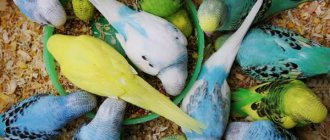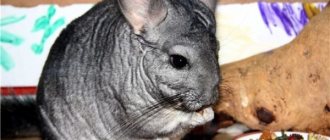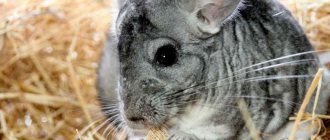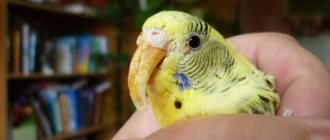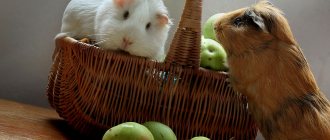Can budgies be given cabbage and why?
Many feathered pet owners wonder whether parrots can eat cabbage. Of course, it should be included in the diet. The white cabbage variety is given by finely chopping it. It is endowed with a large amount of minerals, vitamins and fiber. All this is important for the pet’s well-being.
It is cabbage in winter that is one of the easily accessible vegetables that benefits the parrot. It is best to give your parrot cabbage from your own garden, that is, not treated with chemicals that are harmful to the bird's stomach. Therefore, if possible, prefer home harvest. This also applies to other vegetables, fruits and herbs that are allowed to be given to the parrot. They form an integral part of a regular diet.
Breeders with solid experience notice that their pets are delighted with carrots, rich in carotene, calcium and iron. It is best to grate it using a grater or cut it into small pieces. Some owners treat their parrots to carrots mixed with a boiled chicken egg or cottage cheese. Carrots also go well with zucchini, which is rich in fiber and vitamin B. The vegetable diet of feathered pets includes pumpkin, which contains a lot of sugars and beneficial elements that have a positive effect on the bird’s tone.
It is better not to give Chinese cabbage. Cauliflower can also be included in the category of prohibited vegetables. These varieties will not benefit the bird. It is better to serve any permitted vegetables in chopped form. Cucumbers are legal for parrots and include vitamin E and potassium. Brussels sprouts are also allowed. But it’s better not to pamper your pet with vegetables from the greenhouse; they can be oversaturated with nitrates, which will not benefit the bird’s body. This also applies to tomatoes grown in a greenhouse. Parrots like sweet bell peppers, but they should never give them spicy peppers.
For parrots, eggplants, celery, radishes, and garlic are prohibited; it is better not to overuse broccoli. But you can give red cabbage. The owner of a parrot should always take into account the personal preferences of the ward. If he doesn’t want to eat any of the allowed vegetables, it still won’t be possible to force him. Better try to choose an alternative vegetable.
Before you figure out whether cabbage can be given to your budgie, remember the principles of keeping and caring for your feathered pet. You need to choose a house yourself and equip it with everything you need in advance, before the parrot appears in the house. Think in advance where the cage will be located, what entertainment and toys to hang in it. Make sure the doors in the cage are locked, because smart parrots will eventually learn to open them with their beaks and get out for a walk. Such carelessness will one day lead to the pet simply flying out of the window or being injured.
Mineral and vitamin supplements
In order for your bird’s body to function normally, its cage must always contain food with mineral supplements and vitamins. Because the components contained in regular food cannot be fully absorbed by the bird’s body to a sufficient extent.
We recommend reading: Gamavit for cats preorally
For example, a parrot has a great need (2-3 times higher than normal) for mineral salts during molting. Therefore, it is so necessary to artificially add the necessary micro- and macroelements to the pets’ diet.
What can you give your parrot to eat as a supplement of vitamins and nutrients:
- Sand. The bird's body is designed in such a way that it is not able to digest food in its stomach. To do this, the parrot must eat sand and small pebbles. They mechanically grind food and remove its remains from the bird’s body. If there is no sand in your pet’s enclosure, then proper bowel function will be impossible.
- Chalk. A product containing about 38% calcium. It is very necessary for parrots to strengthen bones and during egg laying.
- Sepia. The shell of the mollusk also contains a large percentage of calcium. It is perfectly absorbed by the parrot's body.
- Eggshell. Contains magnesium, phosphorus, calcium and sulfur. It is boiled in water, dried and crushed, and then placed in a cage.
- Bone flour. Added to feed and mixtures. Flour has a large number of nutritional components important for the parrot’s body.
- Charcoal. A product that is produced by burning birch. Contains a large set of microelements. It is ground into powder and given to the bird along with sand.
You can buy vitamins for your feathered pets at pet stores, or you can add them to your parrots’ food directly from the “improvised products” in the kitchen.
- honey (3-4 drops per 100 ml of water);
- lemon juice (3 drops in a bowl);
- apple cider vinegar (1 ml per 100 ml of water).
These natural components are good antioxidants, rich in vitamins and valuable components that are beneficial for the body of your feathered friend.
What fruits and vegetables can be given to budgies?
Budgerigars are the leaders in the number of households. When a pet appears in a home, it brings a lot of joy and pleasure to its owners. And as a sign of gratitude, the owner surrounds the parrot with care, attention and affection, pampering the pet with all kinds of delicacies. Pays considerable attention to nutrition, which, in addition to everything else, plays an important role in the life of a bird.
The pet is not picky about food. In addition to grain mixtures, his menu should be diluted with fruits and vegetables. Fruits and roots contain a huge amount of essential vitamins and minerals that are involved in the development, growth and health of birds.
Can a budgie eat a cucumber?
You should not use only specialized grain feeds; in addition to them, your budgie should be fed fruits and vegetables (a storehouse of vitamins for your pet). But first you need to find out which of them are necessary for the bird and which can be harmful.
Is it possible to give a budgie a cucumber? This question interests many bird owners. Of course yes. This vegetable is widespread in subtropical and tropical regions, with characteristics close to the bird’s natural habitat.
Fruit menu
Introduce fresh, dried and dried fruits into your parrot's menu. But keep in mind that it is better to make the preparations yourself. When eaten, the bird will not only receive pleasure, but also the necessary content of vitamins and minerals that are necessary daily for the good functioning of the body. Each fruit contains a different amount of useful components. When feeding fruit treats, follow the norm.
Many owners ask various questions: can budgies eat tangerines or kiwis, and what fruits to feed and which not. Let's begin to clarify these issues.
Here are the fruits you can give your budgies:
- Bananas are very nutritious, rich in calcium, magnesium and potassium. Content of fiber, all kinds of useful acids. A couple of pieces a day will be enough to maintain and saturate the body with essential vitamins;
- Apple is a vitamin cocktail, enzymes that are good for the digestive tract. Contains tannins, plant fibers and organic acids. The norm need not be limited;
- pomegranate is very necessary, its substances ensure the functioning of the cardiovascular system. A few grains a day, but introduce them gradually, starting with a minimum amount. The norm per day is no more than 1/6 part;
- kiwi – strengthens the parrot’s immunity. The fruits are leaders in vitamin C content. Protects the body from viruses;
- pears - for digestion, which is promoted by pectin. The composition contains carbohydrates, iron, phosphorus. Peel the skin first. Give in any quantity;
- orange – contains fiber, essential oils, carbohydrates. Well protects the body from viral and infectious diseases. A small piece a day. Also add other citrus fruits to the menu. Dilute lemon juice with water;
- grapes are rich in microelements and vitamins. Give 2 - 3 berries without skin, there is no need to remove the seeds. Cleanses the body and removes toxins;
- pineapple - the composition has a positive effect on muscle tissue and strengthens blood vessels. Has general strengthening properties. Destroys proteins, helps digest and absorb protein foods.
- apricot is the owner of sugar, inulin, starch, provitamin A, iron, acid. Supports the immune system, prevents cardiovascular diseases;
Persimmon, mango, papaya, avocado - these exotic fruits are not recommended to be given to your pet.
Important! Add a variety of edible berries, fresh or frozen, to your diet. You can prepare it yourself in the summer. The treat must be fresh and well washed, otherwise it will lead to serious illness and death.
All fruits should be peeled and cut into pieces. Remove the seeds, which are dangerous because they contain hydrocyanic acid. It is recommended to feed with vitamins from your garden, so-called natural products. Store-bought fruits often contain an abundance of nitrates and other substances that are detrimental to the health of the parrot.
Benefits of cucumbers
Undoubtedly, the cucumber is rich in vitamins and microelements, and is also enriched with water and will not only please the budgie with its crunch, but will also quench its thirst. In addition to its pleasant taste, cucumber is really beneficial for birds due to its high content of nutrients:
Cucumber is rich in various microelements: potassium, magnesium, iodine, zinc, phosphorus and others necessary for the favorable existence of birds. All of them participate in the formation of bone tissue and ease the load on the heart, nervous and digestive systems. Your pet really needs them, which means you shouldn’t completely exclude cucumbers from the list of foods you eat.
Vegetable menu
Fresh vegetables are an integral part of a budgie's diet. Give what you need every day.
Let us explain what vegetables can be given to a budgie:
- cabbage - white cabbage, broccoli, Peking cabbage and other types of this family. Everything contains a lot of all kinds of useful components. It is beneficial for the stomach when consumed, stimulates metabolism and easily cleanses the body of waste and toxins;
- carrots – the root vegetable contains carotene, lysine, ascorbic and pantothenic acid. Promotes pet growth and good vision. One piece a day is enough;
- pumpkin - in addition to its aesthetic qualities, has many useful components. The pulp is saturated with all kinds of vitamins, magnesium, potassium, iron. Removes toxins and excess cholesterol;
- cucumber – a huge content of vitamin E. A rich community of minerals. Helps in the absorption of food and normalize metabolism;
- beets - occupies a leading position in the presence of useful components. It has antioxidants and many other useful minerals necessary for the life of a budgie. Provides a wide range of benefits to improve the functioning of the body.
- Tomato or tomato has obvious benefits for your pet; it is a powerful antioxidant. Is a source for the health of the parrot. Normalizes metabolism, prevents the appearance of fungal diseases.
How to train a parrot to eat vegetables and fruits
Sometimes you encounter that a parrot does not show any interest in additional food. But you shouldn’t despair; with some effort and some tricks, you can overcome the problem. Try to arouse your pet's interest in additional food. You can arrange it in the form of a garland, stringing assorted vitamins in order. Grate and serve as a puree. Eat in front of him and hand feed him. You show all sorts of tricks and tricks. Be patient, and the result will appear soon. Keep in mind that perhaps the parrot will not eat everything, but will choose something that suits its taste preferences.
What to look for when choosing vegetables and fruits
When choosing an assortment of vitamins for your budgerigar, focus on the appearance of the fruits and root vegetables. They should not raise suspicions about quality. Choose fruits and vegetables that are ripe, fresh, and free from mold and rot. Don’t try to experiment with nutrition, just give what you know. If possible, feed only seasonal fruits.
The main diet of a budgerigar is a grain mixture, but a vegetable and fruit menu is also important in the pet’s diet. To maintain health, vitamins and minerals play an important and major role. When eating a variety of food, the parrot’s body receives all kinds of components that saturate the body with all the necessary nutrients.
Follow the rules and regulations for feeding your pet. In return, you get a healthy, active and good-humored parrot that will delight you for many years of life.
Leave your comments and share on social networks.
Sprouted food
Sprouted grain seeds are undoubtedly an excellent treat for your bird. These are products with increased vitamin value.
Sprouted grains block phytates, which slow down the body's absorption of valuable vitamins. This bait will boost immunity, restore vital processes in the bird’s body and ensure normal metabolism.
The following grains are sprouted to feed parrots: oats, buckwheat, millet, barley, wheat. They are washed and then filled with water to the top level of the grain. Unusable grains will immediately float to the surface and must be disposed of.
Then the surface of the saucer is covered with gauze or a light towel. After 24-36 hours, the grains sprout 3 mm and become suitable for birds to eat. You can leave this food in the refrigerator for no more than 4 days.
Vegetables you can give your parrot
Tomato
Tomato is also a good type of food that contains carotene. Tomatoes do not have any side effects on the parrot's body. The parrot is fed only fresh; parrots give special preference to seeds.
Cabbage
Cabbage is also a good food for parrots, which contains a large amount of microelements. Cabbage is valuable for its abundance and long-term storage. This is one of the main food for parrots in winter. It is necessary to feed cabbage to the parrot raw, giving only the leaves whole. The stalk should be finely chopped or grated.
Carrot
Carrots are a particularly valuable food for parrots, containing carotene and many other useful substances. Carrots should be fed only raw, first cut into small pieces or grated. It is recommended to mix with other ingredients, such as boiled eggs, breadcrumbs, etc.
Cucumber
Cucumbers can be included in a parrot's diet, but they are not of great importance. They are consumed only fresh as food containing vitamins and microelements.
Pepper
Bell pepper contains vitamin C. When raw, cut into large pieces and feed to the parrot.
Potato
Potatoes contain a lot of starch, but few vitamins and microelements. You can feed your parrot either raw or boiled, and should be given in small portions. You should not give your parrot tubers that have sprouted or turned green. They contain a substance that is poisonous to parrots - solanine, which can cause poisoning in a parrot.
Pumpkin
Pumpkin also contains carotene, similar to previous fruits. Feed pumpkin raw. Pumpkin seeds have a mild anthelmintic effect.
Beets, turnips, onions, lettuce, spinach
All of these vegetables are also suitable for adding to a parrot's diet. Beets, like cabbage, are valuable for long-term storage. This vitamin food can be fed fresh to the parrot in winter. Onions - mild varieties should be used. In winter, you can sprout onions and give greens in small quantities. Turnips are fed to the parrot in the same way as cabbage; it must be finely chopped or grated. Spinach or lettuce should be given in small quantities. May cause minor digestive upset if taken in large doses in the diet. Do not give the parrot wilted or wet stems; they must be dried.
Wild grass, grass seeds
Weeds are also suitable for consumption, especially during the seed ripening period. For example, parrots willingly eat dandelion baskets. You can also make herbal flour from weeds. Let's take nettle, you need to cut off the upper third of the stem with leaves during flowering, tie the cut stems into a bunch and dry until completely dry. After this, put the bunches in a bowl and crush, the flour is ready. Pour hot water over this flour, strain through a sieve or cheesecloth and add to any liquid mixture for the parrot. You can also use this flour in dry form, you need to sprinkle it with grated boiled egg or soaked bread.
Branches of bushes or trees
Tree branches are necessary for parrots to grind down their beaks. When grinding down the beak, the parrot receives an additional small amount of vitamins and microelements contained in the bark and buds of the branches.
Vegetables for parrots
It is very important for every parrot owner to properly care for him. Is there enough space in the cage, is the temperature in the room acceptable for him, is he getting enough attention, and many other questions arise daily among bird lovers. But among other things, the issue of healthy nutrition for the parrot always comes first.
Currently, any pet store is overflowing with a variety of dry food for any type of parrot. Of course, this is convenient: having bought suitable food in the store, you don’t have to think about what and how to give your parrot. However, it is worth noting that parrots, like people, need vitamins, and due to a monotonous daily diet, a parrot may even stop eating. In this case, the most ordinary, but much-needed vegetables will come to the rescue.
Vegetables are a storehouse of vitamins and nutrients. And their diversity allows you to feed your parrot something new every day. Despite the fact that there are vegetables that are strictly prohibited for parrots. But then natural questions arise: “what vegetables can be given to parrots?”, and “what vegetables do parrots eat with pleasure?”
One of the favorite vegetables for parrots is carrots. Parrots love carrots so much that they always eat them first. And for good reason! After all, it is rich in vitamin A and carotene. And you can give it to birds without restrictions.
What you should absolutely not give to birds
There are certain foods that should never be given to a cockatiel or any other bird:
- Milk can cause intestinal upset.
- The salt and yeast contained in the loaf can cause inflammation of the goiter. It is allowed to add crackers to grated carrots.
- Salt is a poison that leads to the death of a parrot.
- Chocolate can lead to stomach upset, central nervous system disorders and death of the bird.
- Fruit seeds contain cyanide.
- Rhubarb leaves cause intestinal irritation due to the oxalic acid content.
- Tobacco can cause diarrhea and vomiting in birds. Seizures and convulsions are possible.
- Nutmeg can cause nausea, vomiting and dizziness.
- Leaves. The bark and the avocado fruit itself cause heart failure and respiratory system disorders.
- Legumes are also harmful to birds, but they can be fed in small quantities. You cannot feed parrots raw beans; they must be boiled for 30 - 35 minutes.
- Leftover food that the owner eats. Such food leads to indigestion and further obesity of the pet. Because of this, serious diseases can develop, leading to the death of the bird.
A caring owner of a feathered friend must carefully prepare a menu for his pet. Vegetables are an essential part of a parrot's daily diet. They should be chosen very carefully, and then your pet will delight you with its health and beautiful appearance.
READ How to make a bird repeller with your own hands
How to train a parrot to eat vegetables
If you have already figured out the preferences of parrots for vegetables, then now you should definitely find out how to serve vegetables to parrots.
Firstly, you must always purchase only high-quality vegetables. Various additives and mixtures for rapid growth and ripening, liquids that are used to coat vegetables for long-term storage - all this can lead to the death of your pet. But even high-quality vegetables must be checked for freshness to avoid rot and mold.
Secondly, any vegetables must be served to parrots correctly, which means they must be pre-cooked. So, cucumbers and tomatoes need to be peeled, as they contain toxic substances. Pumpkin and melon should be separated from the rind and cut into small pieces. But bell peppers can be given along with the seeds. It is important to remember that vegetables should always be clean.
Many bird lovers often complain that their parrots do not want to eat vegetables and are afraid to even try. Each of them is constantly looking for a solution on how to teach their parrot to eat vegetables. It is worth noting that only the owner’s persistence can overcome the bird’s wariness towards new unfamiliar food.
Before you begin to accustom your parrot to vegetables, you should remember about its structural features of the digestive system. This will help you decide how best to serve your vegetables.
It is necessary to accustom it from the first days, when the parrot began to feed on its own. Place next to dry food and grain crops, gradually adding a new vegetable over time. Make a variety of salads and mixtures. For example, grate fresh carrots and mix them with grated boiled eggs. Another good option is to hang vegetables near the parrot’s treats.
Experienced bird lovers advise getting your parrots used to eating vegetables while playing. So, for example, when training or working with a parrot, you can encourage him with some vegetable, alternating with his favorite treat. Or make a toy out of vegetables and hang it in a cage. This option can easily be made using carrots.
Thus, vegetables help parrots to develop properly. And by following the bird's diet, you can ensure good health for your pet.
What vegetables can a parrot eat?
Proper nutrition is the key to a good life for your feathered pet.
Surely you want your parrot to be healthy and cheerful, but for this you will have to make appropriate efforts.
First of all, you need to take care of a balanced diet for your parrot; therefore, you need to create an optimal diet that takes into account its needs for all nutrients, trace elements and vitamins.
Of course, in the matter of proper nutrition, we must not forget about vegetables, which are considered very useful not only for us, but also for our pets, including parrots.
Therefore, it is worth considering exactly which vegetables can and even should be given to parrots.
Fruits, vegetables and herbs are an important part of a parrot's proper diet, as these foods contain large amounts of vitamins and nutrients, as well as fiber, which is necessary for good health and normal functioning of the bird.
The parrot's daily consumption of vegetables will give it the necessary supply of useful microelements, which is especially useful in winter, when the immune system can be greatly weakened.
During the cold season, parrots especially need vegetables, so be sure to give your parrot these foods.
Of course, an important point in the matter of nutrition is the quality of the products.
It is recommended to feed your parrot only fresh vegetables, fruits and herbs.
Preference should be given to those products that you have grown yourself without the use of various chemicals, since in most cases harmful substances can cause serious damage to the health of the bird.
However, if you live in the city and you do not have the opportunity to grow vegetables and fruits specifically for your parrot, then you can simply walk through grocery stores, study their assortment and choose exactly those fruits and vegetables that, in your opinion, are of the highest quality, in in which the content of chemical elements is reduced to a minimum.
What types of cabbage are allowed?
In Russia, white cabbage is the most popular. You can buy it in almost every grocery store. At the same time, it contains an impressive range of elements useful for birds, and is also unpretentious in storage.
Types of cabbage allowed for parrots:
- Beijing (salad);
- broccoli (asparagus);
- colored;
- kohlrabi.
To feed parrots, it is better to use classic subspecies of crops, avoiding hybrids.
The latter may contain elements dangerous for birds and especially for young animals.
What vegetables can you give your parrot?
- Carrots must be present in your feathered companion’s daily diet, as they contain a large amount of vitamin A, the benefits of which require no comment. You can learn more about this vitamin by reading the corresponding article on our website. Carrots should be given raw, cut into small slices or grated. By the way, the ideal option would be grated carrots with crackers or a boiled chicken egg. Such a salad will be very useful for the parrot, since vitamin A in combination with a large amount of animal protein from the egg will be especially nutritious and will be absorbed by the bird’s body much better and faster. Believe me, your parrot will definitely not refuse such a delicacy and will eat such a salad with great appetite.
- Melon and pumpkin are important elements of proper nutrition. They contain not only a colossal amount of vitamins, but also many other useful microelements, as well as an optimal dose of sugar, which, by the way, is also necessary for the normal functioning of the bird. Melon and pumpkin seeds are the most useful element of these vegetables, since they really contain a lot of vitamins - vitamins A, D, E, K. It would seem that the seeds are small, but the reserves of vitamins in them are really impressive. Pumpkin and melon should be served raw, cut into small cubes or slices. In general, like all other vegetables.
- Zucchini and squash also contain a sufficient amount of vitamins, but most of all these vegetables are useful because they have a high fiber content. A couple of pieces of these vegetables a day and the parrot will not have any troubles. Fiber is especially beneficial for good digestion and gastrointestinal health.
- Cucumbers boast high levels of vitamin E and are an incredible source of clean water. Keep in mind that when buying cucumbers for your parrot in a regular store, you need to pay special attention to their quality, since cucumbers often contain a large number of chemical elements that can cause significant harm not only to the parrot, but even to humans. It may be cucumbers from our own garden, but we understand that not everyone has such an opportunity, so we advise you to buy cucumbers not in supermarkets, but in ordinary stalls or at the market, as they will be safe and most beneficial for the health of your bird.
- Tomatoes are rich in vitamins C and B, as well as carotene. By the way, like cucumbers, they have a large amount of liquid, which will be useful if you do not have the opportunity to give your parrot clean filtered water that is not subject to boiling. Parrots enjoy eating not only the pulp of a tomato, but also its seeds, which contain a significant amount of useful substances. When buying tomatoes, you also need to take into account their quality and avoid those that have an obvious high content of nitrates and other chemical elements.
- Cabbage leaves are a source of a large number of various microelements and vitamins, so you should definitely give your parrot cabbage leaves. Under no circumstances should you give your bird cabbage stalks, as they usually contain a large amount of harmful and even dangerous substances for the parrot. In addition, wet cabbage leaves can serve as a “bath” for the parrot, as it will frolic in them and splash around, which will cleanse its feathers and they will become fluffy and clean. Read more about bathing parrots on our website.
- Bell pepper is very beneficial for the health of the parrot, but only sweet pepper can be given. Hot peppers are not good for your parrot's health and can harm its digestive system. Even if such pepper seems harmless to you, for a parrot it will be really hellishly spicy, therefore, in no case should you give such pepper to your parrot.
Is it possible to give a budgie a cucumber?
All of the above beneficial substances that make up this green vegetable certainly answer positively the question: can a budgie eat a cucumber? First of all, it must be fresh and of high quality, so as not to harm the health of the budgie. You should give preference to homemade cucumbers from the garden rather than store-bought ones (they may contain large amounts of nitrates and other harmful substances that are used to accelerate the growth of the vegetable, treat it against pests and extend the shelf life).
If you live in an apartment building or in a large metropolis and you do not have the opportunity to grow vegetables yourself, you need to be a little more responsible when choosing cucumbers, go to markets, shops and choose from the entire assortment those that inspire confidence. Under no circumstances should you give your budgie cucumbers after cooking (pickled and salted vegetables can cause poisoning or even lead to death).
What vegetables should not be given to parrots?
- Garlic and onions are too hot for parrots. May cause harm to the digestive system. More unpleasant consequences of eating these vegetables by a parrot are also possible.
- Radish is also a very spicy vegetable, therefore harmful to the parrot.
- Eggplant, due to its high solanine content, is very dangerous for the health and life of a parrot.
- Celery contains too many essential oils, which are harmful to the parrot.
- Many other spicy and pungent vegetables.
What greens are good for parrots?
Greens are considered an essential product in a parrot's diet, since their benefits are no less than those of fruits and vegetables, and perhaps even more.
There are a lot of useful substances in greens and parrots eat them with great appetite, which, of course, will only benefit them.
The greens must be clean - do not forget to wash them before giving them to your parrot.
It is recommended to feed your parrot greens without various chemical elements, which you have grown yourself.
Greens, unlike vegetables, can be grown at home without any problems, as a simple houseplant.
So, what greens must be in a parrot’s diet:
- Young nettle leaves treated with boiling water.
- Lettuce leaves.
- Clover.
- Meadow grass.
- Plantain leaves.
- Beet and carrot tops.
This is not the entire list of greens that can be given to a parrot.
What vegetables can you give your parrot?
In order for your parrot to be healthy, you need to take care of it with a properly balanced diet. We have already discussed what to feed a parrot in this article; you can read about what fruits you can give here. Now we will try to talk about what vegetables can be given to parrots?
Vegetables and herbs are another integral part of a healthy poultry diet. Vegetables have large reserves of various vitamins, microelements and fiber.
It is important that all the vegetables and herbs listed below are of proper quality. Always give priority to what you grow yourself. After all, purchased products may contain a large number of different chemicals, as a result of their treatment against pests and to extend the storage period.
Vegetables in a parrot's diet
Carrots are a vegetable that must be present in your parrot’s feeder. Carrots contain a very large amount of vitamin A and carotene. Serve raw, in slices or grated with a boiled egg or breadcrumbs. As a rule, parrots do not refuse such salads.
Pumpkin and melon are also healthy components of the diet. They contain many vitamins and microelements, sugars. The seeds have a lot of vitamins A, D, E, K. Like all vegetables, pumpkin is given raw, cut into pieces.
Squash and zucchini boast fiber content.
Cucumbers are a vegetable containing a lot of water and vitamin E. It is strictly forbidden to give cucumbers from the store, especially in winter. Very often they exceed the permissible nitrate standards even for humans. Cucumbers grown from your garden in the summer can benefit your bird.
Tomatoes – contain vitamins B, C, carotene. Like cucumbers, tomatoes should come from your own garden. Parrots eat both pulp and seeds.
Cabbage - produces green leaves. They are very rich in vitamins and microelements. We recommend not to forget about cabbage, both for the parrot and for yourself, especially in the winter season. Petioles tend to accumulate harmful substances.
Bell peppers – parrots are only allowed bell peppers. Anything spicy is not allowed.
This is not a complete list of vegetables that can be given to a parrot. Below, we will provide a more complete list in pictures. It is also necessary to give your parrot greens.
Forbidden vegetables!
Radish is a spicy vegetable.
Eggplant – contains a substance called solanine, which is also present in green potato tubers.
Celery has a lot of essential oils.
Onions and garlic have a very pungent taste for parrots and contain a lot of essential oils.
Radish, daikon , and all similar spicy vegetables are also prohibited.
Greens in the diet
Greens must be present in the diet, no less than vegetables or fruits.
Make sure that your greens are thoroughly washed under running water. Like vegetables, greens should come from your own garden or rural ecological area, and in no case from the city.
- meadow grass
- burdock (burdock)
- branches of various thicknesses of fruit trees with buds, with young green leaves
- grapevine
- greens of cereal crops: oats, wheat, etc.
- woodlice
- carrot and beet tops
- knotweed
- leaf salads
- nettle leaves scalded with boiling water
- quinoa and spinach in limited quantities
- clover
- plantain leaves
What can a parrot chew?
To do this, you need to regularly add washed tree branches to the parrot's house. But do not rush to carry branches hastily washed under running water into the cage. First, find trees away from the roadway, pick up branches and bring them home.
After that, you should take water into a bowl and leave it there for several hours. Then the branches need to be scalded with boiling water and only then carried into the cage. Firstly, in this way you will get rid of dirt and harmful substances accumulated in the wood. Secondly, if there were parasites on the branches, you can also get rid of them.
You can add twigs to the cage of budgies:
- birch;
- alders;
- linden;
- maple;
- chestnut;
- and you;
- fruit trees (plum, cherry, peach, apricot, pear, apple and others);
- viburnum,
- currants;
- raspberries;
- hazel.
What about house plants? Some feathered pets are very greedy for house plants. Here you should carefully buy flowerpots for your home. Parrots can pinch the following indoor plants: aloe, citrus, yucca, palm trees, Kalanchoe, tradescantia, dracaenas, chrysanthemums, bamboo, crassula, hibiscus.

